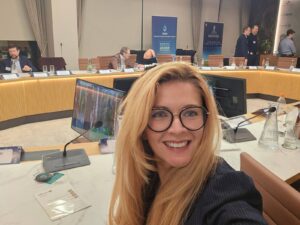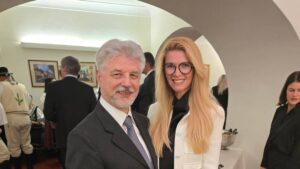How to Communicate Science and Technology Effectively: Our Team’s Experience
Our team has long been dedicated not only to the development of high-performance computing, but also to the effective communication of the results and opportunities we bring to industry, academia, and the next generation of researchers. We consider this a key part of our work – a modern scientific and technological institution today cannot operate in isolation but must be able to clearly and transparently communicate the value and impact of its activities.

That is why we decided to transform our experience into a Best Practice for social media communication tailored to the IT and scientific environment. This document and set of recommendations were developed on the basis of long-term testing of specific approaches in practice and are grounded in tangible, proven results.
Challenges and Communication Needs
When developing our communication strategy, we faced a fundamental challenge: how to effectively and purposefully reach two distinct target groups, each with different expectations regarding content and with different ways of engaging.
On one side, there were professionals from industry, academia, and public administration – individuals with an expert background who are seeking concrete opportunities for collaboration, specialized know-how, and new technological solutions. For this group, credibility, professional authority, and a consistent presence in a professional environment are essential.
On the other side, we needed to reach students, PhD candidates, and young researchers who are interested in new learning opportunities, access to modern technologies, and prospects for careers in science and industry. This group is primarily active on visual and fast-paced platforms, where attractiveness of form, dynamism, and visual style of content play a decisive role.
It became clear that relying solely on NCC Slovakia’s official communication channels would keep our organic reach limited. We therefore needed to find a new way to combine professional communication with an attractive approach tailored to younger audiences.
Our Solution: LinkedIn and Instagram in Complementary Roles
The most effective solution proved to be the systematic use of LinkedIn and Instagram. Each of these platforms has a specific role and addresses a different target audience.
LinkedIn we used it as the primary channel for communication with the professional community. The key breakthrough was that we did not limit ourselves to the official NCC Slovakia page. We also engaged the personal profiles of our employees, HPC ambassadors, and management. They shared posts, tagged the official profile, and created their own content that naturally referred back to our activities. This approach significantly increased the credibility of the content, as it was not spread solely through an institutional channel but also via individuals with professional reputation. The result was not only greater reach, but also more interactions, shares, and organic growth in the number of followers.
Instagram proved to be an ideal platform for communication with students and young researchers. We focused on visually engaging content – posts, stories, and reels – that promoted our courses, workshops, and events. Collaboration with university faculties and student organizations also proved effective. With their consent, we tagged them in our posts, which these institutions then shared further. In this way, our invitations to free courses reached students directly, leading to the quick filling of capacities for several training sessions.
Concrete Results
Our Best Practice delivered measurable results. Within just a few months, we recorded a significant increase in both reach and engagement:
- LinkedIn The number of followers grew organically from 500 to 593 between January and July 2025, providing clear evidence of the effective engagement of personal profiles and consistent activity.
- Instagram Regular campaigns ahead of courses and events proved to be key for registrations – analytics confirmed that the highest number of click-throughs to registration links came directly from Instagram.
- Combination of Both Channels made it possible to specifically reach both professionals and younger audiences and to turn increased awareness into actual participation in our activities.
Why This Approach Is Successful
Our recommendations show that effective communication in the IT and scientific sphere does not require large financial investments. What is essential are primarily an understanding of social media algorithms, the ability to tailor content to the target audience, and the willingness to involve people from within the organization in communication. Thanks to this approach, we were able to increase credibility, reach, and engagement without incurring additional costs.
Conclusion
Our Best Practice demonstrates that systematic and well-thought-out communication on social media can be a key tool for institutions in the fields of IT and science. It not only helps build a brand and raise awareness of activities, but also directly contributes to achieving concrete goals – whether by increasing participation in courses, supporting young researchers, or strengthening collaboration with industry and academia.
Our ambition is to further develop this approach and share it with partners both at home and abroad. We believe that these experiences can also be valuable for other institutions seeking ways to communicate effectively in the digital space while strengthening their professional reputation and societal impact.
We are pleased to note that, based on the document prepared within the EuroCC2 project, we have been invited by the Project Management Team to present our experience at the international all-project conference to be held in Tallinn in September.
We see this as a recognition of our work to date, which at the same time confirms the importance of Slovak expertise in the European context. For us, it is a clear signal that long-term systematic efforts, the building of know-how, and strong links with the international community are delivering results. It also confirms that Slovakia is capable of providing valuable solutions in the fields of HPC and artificial intelligence, while actively contributing to Europe’s common goals in digitalisation, innovation, and technological sovereignty.
We also see this recognition as a commitment – to continue strengthening our expertise, expanding services for industry and academia, and reinforcing international ties that help Slovakia consolidate its position within the European HPC ecosystem.
 Success story: AI Helps Save Women’s Lives 17 Dec - Strach z rakoviny prsníka je tichým spoločníkom mnohých žien. Stačí jedno pozvanie na preventívne vyšetrenie, jeden telefonát od lekára či jedno čakanie na výsledky – a myseľ je plná otázok: „Som v poriadku?“ „Čo ak nie?“ „Môže sa niečo prehliadnuť?“
Aj keď skríning potvrdí negatívny nález, obavy často pretrvávajú.
Success story: AI Helps Save Women’s Lives 17 Dec - Strach z rakoviny prsníka je tichým spoločníkom mnohých žien. Stačí jedno pozvanie na preventívne vyšetrenie, jeden telefonát od lekára či jedno čakanie na výsledky – a myseľ je plná otázok: „Som v poriadku?“ „Čo ak nie?“ „Môže sa niečo prehliadnuť?“
Aj keď skríning potvrdí negatívny nález, obavy často pretrvávajú. VICE and the Digital Twin at the Pre-Christmas Hydrogen Infoday 11 Dec - Dňa 10. decembra 2025 sme sa zúčastnili podujatia Predvianočný vodíkový Infoday v Bratislave. Súčasťou programu bola prezentácia VICE – Vertical Integrated Cyclic Energy, Hydrogen, vedená Laurie Farmerom a Luciou Malíčkovou.
VICE and the Digital Twin at the Pre-Christmas Hydrogen Infoday 11 Dec - Dňa 10. decembra 2025 sme sa zúčastnili podujatia Predvianočný vodíkový Infoday v Bratislave. Súčasťou programu bola prezentácia VICE – Vertical Integrated Cyclic Energy, Hydrogen, vedená Laurie Farmerom a Luciou Malíčkovou.  Strengthening Slovak–Romanian Cooperation and the Development of Scientific Partnership 8 Dec - Romania’s National Day is a significant historical milestone commemorating the Great Union of 1918, when Transylvania, Bessarabia, and Bukovina united with the Kingdom of Romania. This moment laid the foundations of the modern Romanian state and remains a powerful symbol of national identity and unity to this day.
Strengthening Slovak–Romanian Cooperation and the Development of Scientific Partnership 8 Dec - Romania’s National Day is a significant historical milestone commemorating the Great Union of 1918, when Transylvania, Bessarabia, and Bukovina united with the Kingdom of Romania. This moment laid the foundations of the modern Romanian state and remains a powerful symbol of national identity and unity to this day.
